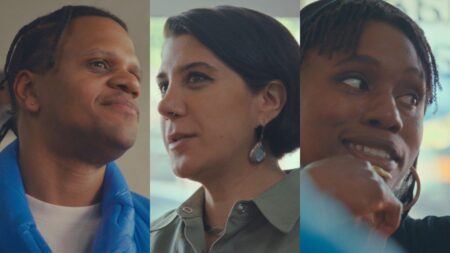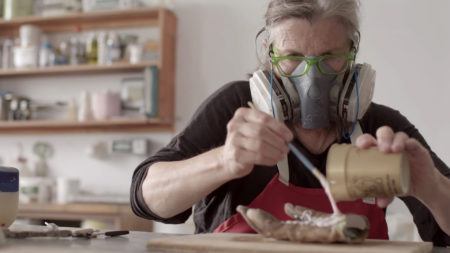Interview
Storytelling

Hubbard/Birchler. House with Pool, 2004. High Definition Video with sound transferred to DVD 20 min 39 sec, loop. Installation at Tanya Bonakdar Gallery, New York. Courtesy of the artists and Tanya Bonakdar Gallery, New York.
Artists Teresa Hubbard and Alexander Birchler discuss the methodology of storytelling in their films.
ART21: What is the role of the viewer in your work?
HUBBARD: Embedded in how we make and exhibit and how we think about these works is the requirement that a viewer participate in the authorship of the story. I don’t want you to lose yourself in the same way that you’re being taken on a rollercoaster ride, which is the common Hollywood experience.
ART21: Hollywood offers entertainment. What you do in the work House with Pool is different from that.
BIRCHLER: Classic Hollywood, standard Hollywood, is: you enter the cinema, you lose yourself, and you exit. What we do: you’re going in and out; it’s your entrance, your exit. There’s complete absorption, and then there’s rejection of absorption. That’s what we’re trying to do—to reflect back onto you.
We play very consciously with the fact that we want to make the viewer aware of the medium in itself or in the story—that you sort of step in and out of a story. It’s not like we want a complete absorption and then—boom, you’re out of it! But there’s a moment when we strongly want you as a viewer: you’re in this house, around the pool, you’re fully immersed. And then there’s a moment when we go through the wall. For a moment, we want the person who’s questioning that, and then he’s back into full immersion.

Hubbard/Birchler. House with Pool, 2004. High Definition Video with sound transferred to DVD
20 min 39 sec, loop. Courtesy of the artists and Tanya Bonakdar Gallery, New York.
ART21: What was your earlier work like?
HUBBARD: Our early works started with the making of museological sorts of installations and dioramas. It’s almost like we followed the path of Daguerre and early photography through early filmmaking—picking up some of those structures. It’s only been recently, looking back, that we have been aware of following that path.
BIRCHLER: We also left photography; we say that’s what we did before. When we met, if we were trained as anything, we were probably trained as sculptors.
HUBBARD: In our early photographic works, I was really interested looking at literature written around the time that photography entered the cultural mainstream—always looking at from which vantage point, from which perspective, which voice is one using, and how can one slip between different voices? Specifically looking at Madame Bovary—Flaubert seemed to have written the book with a camera strapped around his neck. He would sort of swoop through the wall and be zoomed in on Emma in her moment of anguish. Then, in the very next sentence, we would be outside, from her point of view, as she’s looking outside of the room that enclosed her. The whole buildup around her seemed to be shot and counter-shot and a zoom. He sees the whole village and then, in the next shot, he’s in the cupboard with Emma. There’s the village—and also this kind of slipperiness between the subjective and the objective. And that’s still the place where I don’t think we’re finished exploring.
In a lot of the camera work that we use, it’s this mechanical, objective, unblinking, unfeeling eye that seems not to give a damn. However, there are moments, rather like when you walk past someone in trouble on the street—that there’s a moment when you might pause, and then obviously the decision is to keep going or to stop and actually change something. And particularly in this trilogy (Eight, Detached Building, Single Wide), one of the consequences of that unblinking and uncaring eye is that it might slow down, but it’s probably more slowing down in a moment of curiosity rather than one of sympathy.
ART21: What part does symbolism play in a work like House with Pool?
HUBBARD: House with Pool is a long piece, and there are different readings, depending on when one enters. One person at the opening came in when the young woman is putting a sweater on the chair. His reading was: it’s hers, and she’s putting it there to be picked up later.
BIRCHLER: If you come in earlier, you have much more feeling that it’s the mother’s, and that she leaves it there unconsciously for the daughter. However, you didn’t see the gesture.
When we started this piece, we basically just spent the whole summer in this house. And so, there are a lot of stories. One of the positions is that we made a decision. Some things had to be unveiled somewhere. And it was the pool that we chose for that because of course it’s metaphoric: the transparency with a hint of possible hiddenness, the drowning, and all these things. What drew us to the deer was that it was a wild animal. And the teenager has this wildness.
HUBBARD: For me, of course, I see it as symbolic. Something had to be submerged in that world of the pool. Something had to be pulled up and held like a child. And it had to be wild. I think something that also attracted us about deer: they’re very quiet animals. Sometimes when they’re scared, they’ll snort, but they’re in that same realm of silence as the characters.

Hubbard/Birchler. Eight, production still, 2001. High Definition Video with sound transferred to DVD
3 min 35 sec, loop. Photo by Shaune Kolber. Courtesy of the artists and Tanya Bonakdar Gallery, New York.
ART21: What elements must you have to make a story?
BIRCHLER: For example, with the work Eight, there’s this girl who seems to be aware of something else at her party. We hear the kids in the background, maybe some adults, singing songs. She leaves the party; she goes outside. And she seems to have this obsession to try to get her piece of cake back inside. So, we are very close with her, and she seems to see something as she looks outside. That’s this moment of awareness, and the struggle is obvious. The struggle is to go through that rain. It’s a metaphorical struggle, a girl in this nice dress being followed by the storm. And the storm is following her, even inside the house. So, there’s a moment of disturbance in this seemingly perfect setting of a young girl growing up in this very nice home.
The loop is inherent to the story. It indicates a kind of self-centeredness. It’s the character’s state of being. And by seeing the story unfolding again and again, there seems a sense of a certain amount of obsession that becomes more and more obvious. It’s like she always gets the piece of cake and never gets to eat it. She doesn’t get to, so there’s a very strong sense of obsession about that character.
HUBBARD: I think that, given where I come from and what bias and expectations towards visual art I have, storytelling is something that I can’t shake loose. Storytelling has not always been fashionable, you know. But it’s something that I embrace. It’s just fundamental to who I am. Sitting down with a blank piece of paper almost never happens. Usually it’s kicked off by a place, a room, a drawing—something that’s seen. For me, a character or protagonist has to be subjected to some kind of moment of interiority. I don’t want to get more specific than that. And whether or not they accept that or how deep that interiority goes, that’s left completely open.
For me, it’s always been about the story—how to tell and untell a story. That’s always been my interest as an artist. And it’s always been the kind of work that I’ve been most drawn to.



